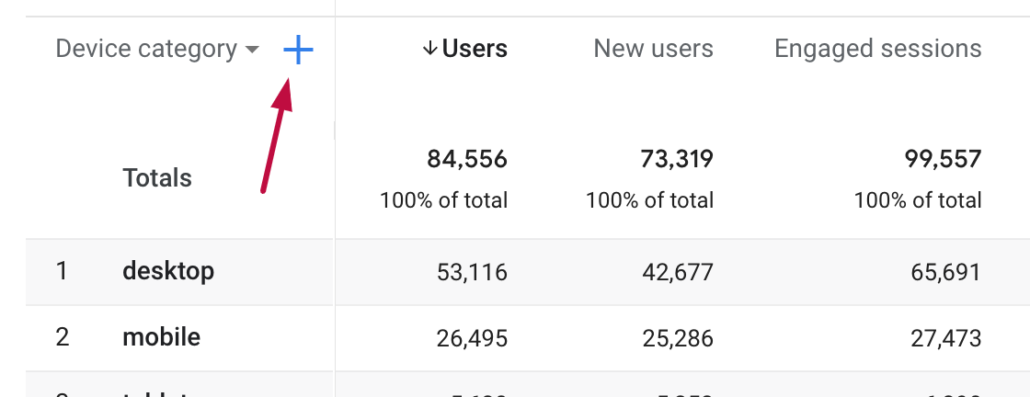The Relevance of Secondary Dimension in Google Analytics for Your SEO
The Relevance of Secondary Dimension in Google Analytics for Your SEO
Blog Article
Unlock Deeper Insights With Second Measurement in Google Analytics
With the vast area of data readily available in Google Analytics, the usage of secondary measurements can significantly improve your analytical capacities. By strategically including additional dimensions into your evaluation, you can discover important understandings that might otherwise continue to be obscure - Secondary Dimension in Google Analytics.
Recognizing Primary Vs. Additional Measurements
When examining information in Google Analytics, it is important to compare key and secondary measurements to gain deeper understandings into customer behavior. Key dimensions are the primary categories whereby you can see your information, such as source/medium, tool, or landing web page. These measurements supply the basic framework for organizing and comprehending your data. On the various other hand, secondary dimensions permit you to more study your key measurement information. By adding a second measurement, you can layer on added info to your main dimension, allowing a much more granular analysis. If your primary measurement is the source/medium through which users showed up on your site, adding a second measurement like geographic area can disclose where those customers are situated geographically. When looking at the key measurement alone, this added layer of details can assist you determine trends, patterns, or abnormalities that may not have been noticeable. Consequently, leveraging both additional and main measurements in Google Analytics is crucial for extensive information analysis and educated decision-making.
Utilizing Secondary Measurements Efficiently
By including second measurements along with key measurements, experts and online marketers can delve much deeper into the specifics of customer interactions on their websites. Secondary dimensions allow individuals to sector and filter main dimension information even more, offering an extra comprehensive sight of user interactions, demographics, and actions.
In addition, secondary dimensions allow individuals to compare and contrast different data points within a single record, assisting in a more comprehensive analysis of individual habits patterns. By leveraging secondary dimensions successfully, businesses can reveal hidden understandings, optimize their advertising and marketing strategies, and enhance the overall user experience on their web sites.
Checking Out Common Additional Measurement Mixes
To further examine user actions and trends in Google Analytics, it is valuable to check out usual mixes of additional measurements. Some usual additional measurement mixes that provide useful insights include analyzing web traffic sources with individual locations to comprehend where website site visitors are coming from geographically and just how they discovered the website. Examining customer habits metrics with second dimensions such as rate of interests or demographics can help in targeting details audience segments more efficiently.
Applying Additional Measurement in Custom-made Reports
Making use of additional measurements in customized reports permits a more official source thorough evaluation of information in Google Analytics, enhancing the deepness of understandings acquired. When producing personalized reports in Google Analytics, including additional dimensions can supply an extra thorough sight of just how various dimensions engage with each various other. This function allows customers to dig deeper into their information and reveal beneficial correlations that might not be immediately evident.
By using secondary measurements in custom-made reports, users can gain a far better understanding of their internet site or application website traffic. For instance, incorporating the main dimension of "source/medium" with the secondary dimension of "touchdown page" can reveal which landing web pages are carrying out ideal for website traffic originating from particular resources. This insight can help marketing professionals enhance their projects and boost general conversion rates.

Enhancing Data Visualization With Secondary Dimension
When exploring data in Google Analytics custom-made reports, integrating additional measurements not just supplies a more thorough analysis however likewise improves the aesthetic representation of understandings through data visualization. By including an additional measurement to your records, you can improve the means data exists, making it much easier to identify patterns, trends, and correlations within your site's efficiency metrics.
Secondary measurements can help you sector your data additionally, enabling a deeper understanding of user habits and communications on your website. When trying to separate details variables that might influence your web site's performance., this improved level of granularity can be particularly useful.

Conclusion
To conclude, leveraging secondary measurements in Google Analytics permits a much more extensive evaluation of data, causing deeper insights and even more educated decision-making. Secondary Dimension in Google Analytics. By adding extra layers of info to key data sets, online marketers and analysts can reveal covert patterns, patterns, and relationships that supply a granular view of customer habits and communications. This boosted level of understanding allows optimization of campaigns and customized techniques for particular target market sections, ultimately improving performance and conversion prices
On the various other hand, additional dimensions allow you to more study your primary dimension data. By including a secondary dimension, you can layer on added details to your main measurement, enabling a much more granular evaluation. If your main dimension is the source/medium with which customers arrived on your site, including a second measurement like geographic area can disclose where those individuals are located geographically. By including second measurements along with key measurements, marketers and analysts can delve much deeper into the specifics of customer communications on their sites. Secondary dimensions permit individuals to section and filter key dimension information better, providing a more comprehensive sight of user interactions, demographics, and habits.
Report this page